|
Benchmarking
The graph below shows the results from the UT2003
flyby benchmark.
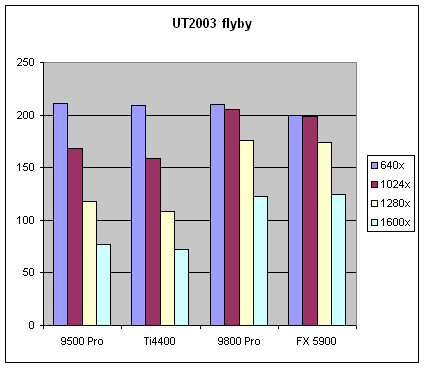
Not much news here, except that at higher
resolutions the older cards fall pretty far behind. The next graph shows
the UT2003 botmatch scores.
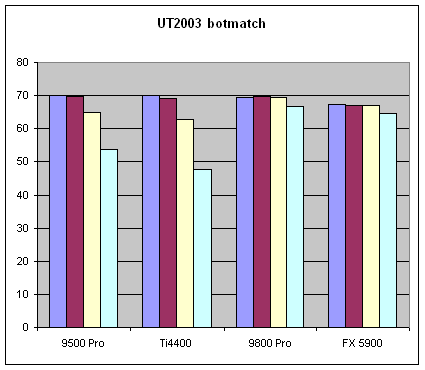
It's interesting that there is so little
difference between the cards in this test. I'm not sure these results
reflect real life performance in the game, because I noticed a big
difference on my machine when going from the Ti 4400 to the Radeon 9800,
even when playing UT2003 at a resolution of 1024 x 768.
Codecreatures is a high polygon-count benchmark
that brings most systems to their knees.
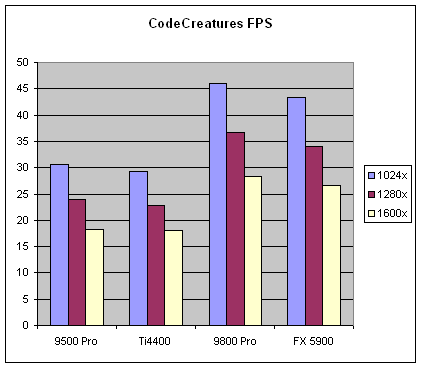
Older video cards rarely exceed 30 frames per
second, even at low resolutions. Indeed, at 1024 x 768 x 32-bit color,
even the two high-end video cards only hovered around 45fps, with
the Radeon beating the FX by a slight margin.
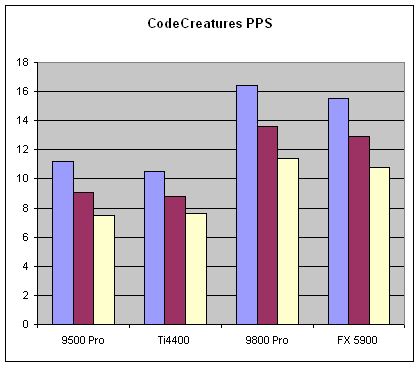
Codecreatures also gives data on millions of
polygons per second, and in this department the Radeon keeps it's slight
lead over the FX at all resolutions.
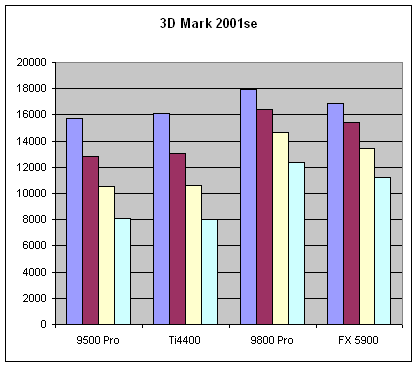
The 3D Mark 2001se scores are not too
interesting. This DX8.1 benchmark doesn't strain the new cards
enough to really differentiate between them. At lower resolutions,
the new cards aren't even much better than the old video cards.
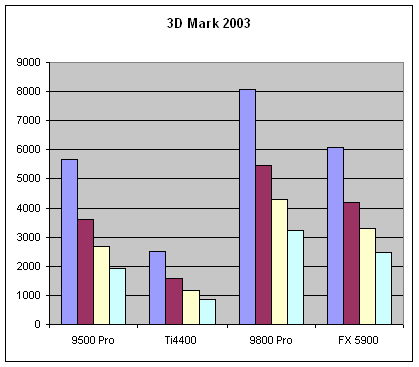
Despite all the hoopla about 3D
Mark 2003 being a synthetic benchmark that does not measure real-world
performance, this is clearly the one benchmark I used that clearly
differentiated these two new cards from one another. The differences
observed between the 9800 and 5900 in the other benchmarks were trivial in
comparison. Here, the Radeon spanks the FX card. Further, the GeForce
Ti4400 is pretty much worthless in this test, even compared with the 9500
Pro from ATI. Also notice that the older and very inexpensive 9500 Pro
almost keeps pace with the brand new, very expensive 5900 Ultra.
That's embarrassing.
Keep in mind that there will not
be any games using DX 9 technology until this Winter at the earliest, so
there is no way currently to test how these cards will fare with actual
DX9, high polygon-count games. Code creatures gives us some idea of how
high polygon-count games might perform with current hardware, but it is
not an actual game with artificial intelligence and plenty of bots on the
screen, so we are still stuck in limbo waiting for a true DX9 title to
come out, like Half Life 2 or Doom III.
I should mention that as far as high-end video
cards go, the Jaton 5900 has some of the worst "fit and finish"
work I've seen. The heat sink had jagged edges, and seemed very
poorly made when compared with offerings from companies like Asus.
The Jaton card was first to market, probably because they cut
manufacturing corners. If you're going to get an FX 5900, look for
something from Asus, Gigabyte, or another, more reputable company. If they
had used faster memory and a better cooling solution, like Asus does on
their 5900 card, the NVidia card would have probably faired better than it
did against the Radeon 9800 Pro. I may need to do a rematch when I can get
a hold of the offering from Asus.
One final comment on ATI's newest 3.6 Catalyst
Drivers. They installed perfectly and quickly, and have a great deal
of excellent features. I noticed only one bug. I have the Mitsubishi
2070sb Diamond Pro monitor, and I am using the Radeon 9800 Pro. These two
devices are DDC/CI (Display Data Channel Command Interface) compliant
devices, but NEC-Mitsubishi's "Naviset" display control applet
failed to recognize my 2070 monitor. Therefore I could not use the
software to adjust my monitor, and I was stuck with the front panel
buttons. The problem is a known issue with the last 3 sets of Catalyst
drivers. ATI says the next release will fix the problem.
Conclusions The conclusions
that I come to after doing this mini-review are: 1) that the Radeon 9800
Pro is a slightly better video card than the NVidia FX 5900, and that; 2)
right now you probably don't need either video card to play existing
games. You will probably want one by the end of the year when new DX9
games make it to the stores. But by then, newer versions of both cards
should be available, and prices may be slightly lower.
ATI
Pros and Cons
- Pro > Fastest video card available
- Pro > Excellent image quality
- Pro > Excellent features
- Pro > Versatile 2 monitor
setup
- Con > Very expensive
NVidia Pros
and Cons:
- Pro > Very fast
- Pro > Excellent image quality
- Pro > Excellent features
- Pro > Versatile 2 monitor setup
- Con > Fit and Finish poor (Jaton
specific)
- Con > Two slot AGP card
- Con > Very expensive
|
RATINGS:
ATI Radeon 9800+:
Price:
Approximately $390 US retail
Rating, :
4.9 out of 5 smiley faces (98%).
:) :) :) :) +
Availability:
Moderate
Jaton GeForce FX 5900:
Price:
Approximately $390 US retail
Rating, :
4.4 out of 5 smiley faces (88%).
:) :) :) :) +
Availability:
Moderate
|
© Copyright, August 10th, 2003 KickAss
Gear
|